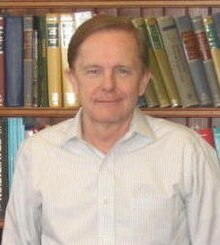Thomas Appelquist
Thomas W. Appelquist (born November 1, 1941 in Emmetsburg , Iowa) is an American theoretical physicist who deals with elementary particle physics.
Appelquist studied at Cornell University , where he received his doctorate in 1968 . He then worked at the Stanford Linear Accelerator Center until 1970 . From 1970 he was at Harvard University and from 1975 at Yale University , where he was Professor of Physics in 1976 (from 1991 Eugene Higgins Professor) and from 1983 to 1989 Chairman of the Physics Department and then until 1993 Director of the Physics Department and engineering. From 1993 to 1998 he was dean of Yale's Graduate School. From 1993 to 1996 he was President of the Aspen Center for Physics in Aspen , Colorado . In 1975 he was at the Institute for Advanced Study .
Appelquist has been a member of the American Academy of Arts and Sciences since 1993 , received the Humboldt Research Prize and the 1997 Sakurai Prize . In 1974 he received a research grant from the Alfred P. Sloan Foundation ( Sloan Research Fellowship ). In 1984 he became a Fellow of the American Physical Society .
In 1974 Appelquist and David Politzer predicted the charmonium and calculated its spectrum. He also dealt with Kaluza-Klein theories (partly with Alan Chodos) and Technicolor theories (among other things, he introduced Walking Technicolor). With Carazzone he proved a decoupling theorem in 1975, which is used in GUTs to show that the superheavy particles predicted by these theories have no effects on physical observables in the low-energy range, since their contributions have the order of magnitude of the inverse mass and are thus suppressed .
Fonts
- as editor with Peter Freund and Alan Chodos : Modern Kaluza Klein Theories (= Frontiers in Physics. Vol. 65). Addison-Wesley, Reading MA 1987, ISBN 0-201-09829-6 .
Web links
- Thomas Appelquist. Yale University
- 1997 JJ Sakurai Prize for Theoretical Particle Physics Recipient: Thomas Appelquist. APS
References
- ↑ The name comes from both. Also known as the J / ψ meson , the bound state of charm and anti-charm quarks
- ↑ Th. Appelquist, D. Politzer: Heavy Quarks and annihilation . In: Phys. Rev. Lett. tape 34 , 1975, pp. 43 , doi : 10.1103 / PhysRevLett.34.43 . ; Th. Appelquist, A. De Rújula, H. David Politzer, SL Glashow: Spectroscopy of the new mesons . In: Phys. Rev. Lett. tape 34 , 1975, pp. 365 , doi : 10.1103 / PhysRevLett.34.365 .
- ↑ Th. Appelquist, A. Chodos: Quantum Effects in Kaluza Klein Theories . In: Phys. Rev. Lett. tape 50 , 1983, pp. 141 , doi : 10.1103 / PhysRevLett.50.141 .
- ↑ Th. Appelquist, D. Karabali, LCR Wijewardhana: Chiral Hierarchies and Flavor-Changing Neutral Currents in Hypercolor . In: Phys. Rev. Lett. tape 57 , 1986, pp. 957-960 , doi : 10.1103 / PhysRevLett.57.957 .
- ^ Th. Appelquist, J. Carazzone: Infrared Singularities and Massive Fields . In: Phys. Rev. D . tape 11 , 1975, p. 2856 , doi : 10.1103 / PhysRevD.11.2856 . ; Th. Appelquist, J. Carazzone: Physical Processes and the Infrared Problem in Gauge Theories . In: Nucl. Phys. B . tape 120 , 1977, pp. 77 , doi : 10.1016 / 0550-3213 (77) 90096-7 .
| personal data | |
|---|---|
| SURNAME | Appelquist, Thomas |
| ALTERNATIVE NAMES | Appelquist, Thomas W. |
| BRIEF DESCRIPTION | American theoretical physicist |
| DATE OF BIRTH | November 1, 1941 |
| PLACE OF BIRTH | Emmetsburg , Iowa |

